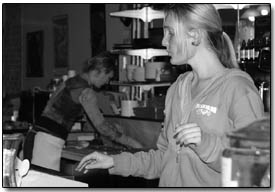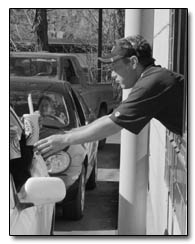 |
| Steaming Bean employee Marisa
Affolder rings up a customer while Sadye Wissman, background,
helps out in the back. Although the country as a whole is
experiencing unemployment rates hovering in the 6 percent
range, Durango and La Plata County are anomolies, with a
rate at 4 percent. Local economic experts speculate that
the area’s high cost of living has something to do
with the lower rate./Photo by Todd Newcomer. |
As the nation copes with what
is being called the worst job market in a decade, Durango and
La Plata County have remained relatively immune. However, while
local unemployment levels are well below national and state
levels, all is not rosy for Durango workers.
In December, unemployment nationwide hit 6 percent, marking
the highest level of jobless Americans since 1994. Job availability
has been plummeting since the recession began in March of 2001,
and the number of jobs lost since that time is the highest in
nearly 20 years. For the State of Colorado, the picture was
somewhat brighter in December with a 5.2 percent unemployment
rate. By comparison, La Plata County has remained relatively
unscathed. Locally, the rate of unemployment has bucked national
trends, remaining at 4 percent in December.
No need to panic
Bobby Lieb, director of the Durango Area Chamber of Commerce
and the La Plata County Economic Development Action Partnership,
said that 4 percent unemployment is ideal.
“We are at about a 4 percent unemployment rate locally,
which is well below state and national numbers,” said
Lieb. “Four percent is what I would call a healthy unemployment
rate. You get much lower than that and you start employing the
unemployable.”
Ed Morlan, executive director of the Region 9 Economic Development
District, concurred that La Plata County appears to be weathering
the unemployment storm.
“We’re in the wintertime which typically has a
higher rate of unemployment,” he said. “But on a
gut level, I’d say I don’t think it’s particularly
drastic right now.”
Morlan added that while local businesses like K-mart and the
Silverton Millworks have recently laid off hundreds of workers,
new business like Home Depot and new small businesses are buoying
up the local job market. “There certainly are going to
be some people losing their jobs, but I don’t think it’s
cause for panic,” he said. “There are a number of
new businesses coming into the private sector.”
Ironically, Lieb credited the Durango area’s high cost
of living for the low unemployment rate. He plainly said that
people can’t afford to be unemployed in La Plata County.
“The cost of living, and specifically the cost of housing,
doesn’t afford the luxury of hanging around and waiting
for something better to come along,” he said.
 |
| Mark Little, of Maria’s
Bookshop, stocks shelves at the store Monday. Originally
from Pennsylvania, Little has a bachelor’s degree
in biology. However, like many who move to Durango, he is
not able to find work in his field./Photo by Todd Newcomer. |
The waiting game
When she moved to Durango more than two years ago, Tracy Korb
was one person who tried to wait as long as possible for the
job she wanted. Korb came to Durango from New York City by way
of Edwards, in the Vail Valley. In New York, she spent six years
working in marketing and communications. She then made a lifestyle
decision, forgoing the career and moving to Edwards. “I
was mainly working seasonal jobs,” she said. “But
in the Vail Valley, at least you get paid good money.”
Tired of ski bumming, she planned a move to Durango, viewing
the town as a way to balance lifestyle and career. “I
thought that by moving to Durango I would have an opportunity
to get back into real work,” she said.
Armed with her six years of marketing experience, Korb skipped
the classifieds and starting contacting communications-related
businesses directly. After her phone calls went unanswered,
she started poring over the classifieds.
“A lot of people still wouldn’t call me back even
though they were advertising job openings,” she said.
“I felt like I was basically qualified to do anything.
But people seemed really slow on responding from the employers’
side.”
After a month, Korb was eventually driven to a temporary agency,
which found her work in the office at Waste Management. Two
weeks later, her job search finally paid off, and she landed
the job she’s had for the last two years – membership
and communications coordinator for the Women’s Resource
Center.
Korb said she’s happy with her work but doesn’t
view Durango as a land of opportunity. “I just don’t
see a lot of options in Durango unless you create your own,”
she said. “You have people with masters degrees and doctorates
tending bar because they can make more money. But then again,
people don’t move here for work. They move here for the
lifestyle.”
Cashing lean paychecks
Connie Ackerman, labor and employment specialist with the Southwest
Colorado Workforce Center, agreed that many of Durango’s
more prestigious positions also have some of the lowest salaries.
“I don’t know if high paying and professional job
even go together here,” she said. “Those jobs really
aren’t available. People with doctorates are hoping to
wait tables because that’s one of the better paying jobs.”
Lieb agreed that La Plata County is experiencing a wage crisis.
“In terms of wages, we’re still well below the state
and national averages,” he said. “There’s
a dramatic disparity between wages and the cost of housing.
That’s an area where we drastically need improvement.”
 |
Brendon Hays, a DHS graduate,
works
the Burger King drive-thru Monday./Photo by Todd Newcomer. |
Lieb added that the problem may begin to address itself as
Durango’s job base diversifies. He said that while high-paying
professional opportunities seem few in number, they have increased
over the past years and are continuing their climb.
“I would argue that professional opportunities have been
growing in the community,” he said. “By definition,
we’re still considered a rural area, and there just aren’t
the jobs that are available in urban areas. But our job base
is diversifying.”
As evidence, Lieb pointed to a drop in the percentage of locals
working in the tourist industry. He noted that three years ago,
35 percent of La Plata County residents had tourism-based jobs.
This year, that number is down to 24 percent.
Outside looking in
However, the future remains uncertain. A portion of the Southwest
Colorado Workforce Center’s duties revolve around finding
temporary work for residents. Ackerman said that in her 19 years
with the agency, the list of available jobs is as short as she
has ever seen it.
Mark Prouty, branch manager of SOS Staffing Services, said
that even though winter is a traditionally slow time for temp
agencies, his list of available jobs is also shorter than usual.
He added that competition for the list has been stiffer with
calls from people outside the area on the rise.
“We getting a lot more inquiries from outside the area
from people who are going to relocate,” Prouty said.
And while people may be in a hurry to relocate to La Plata
County, they may share Korb’s experience once they get
here. Ackerman said this may be particularly true in light of
Durango’s current economic situation.
“Even though it took some time to trickle in here, we
all know that 9/11 had a big impact,” she said. “We’re
certainly still also in the throes of drought. It’s a
tough time in Durango. It’s a very tough time.”

